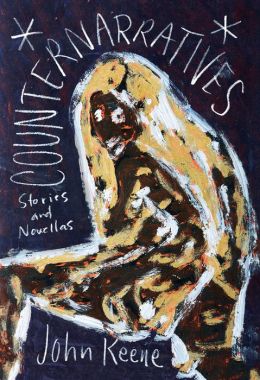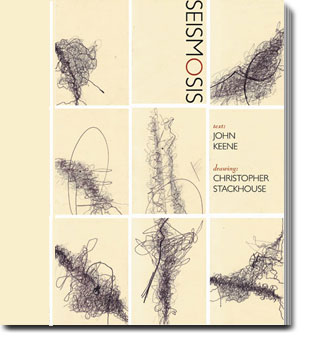 |
Mei-Mei Berssenbrugge
(Kelsey Street Press) |
It was only a matter of time before I posted a poem by
Mei-Mei Berssenbrugge (1947-) during this month's ekphrastic/art poem cavalcade; she published a marvelous new and selected volume entitled
I Love Artists: New and Selected Poems (University of California Press) in 2006, and has collaborated extensively with her husband, the highly lauded painter and sculpture
Richard Tuttle (1941-) over the years. In fact I am a huge fan of her work, and this post marks
the third time I have featured a poem by Berssenbrugge, and the other two also could be said to deal with aspects of art and poetry.

This poem, however, explicitly explores the work of two poets Berssenbrugge knows,
Kiki Smith (1954-), perhaps best known for her sculptures, figurines and prints, which have explored human bodies and our excreta, feminism, and the
AIDS pandemic, among other themes, and
Bruce Nauman (1941-), the conceptual artist whose work crosses a range of media, including the televisual.
"I Love Artists" is one of many favorites in the 2006 collection, and I was reminded of it again when I happened upon it on the
Painters and Poets blog, which for a number of years focused on the very topic I am posting about this month, poetry and visual art. The organizers of that blog created a real treasure, and stopped blogging last year, but the archives are still up at the link above, so be sure to check it out. They also offer their distinctive takes on
Jorie Graham's "San Sepolchro" and other poems I've posted about here.
In the poem below, Berssenbrugge references Smith's drawing "Blues Stars on Blue Trees," a 2006 work, using ink and silver leaf, on Nepal paper, and Bruce Nauman's video piece, "Mapping the Studio 1 (Fat Chance John Cage)," from 1981, which appeared at Dia Center for the Arts back in 2001-2. It was, I can say as someone who went to see it, extremely dull, but, in the way that
Andy Warhol's extended cinema could also be, quite fascinating as an idea and in practice. (It lacked the minute-to-minute excitements and spark of other extended works like
Christian Marclay's
The Clock.)
One thing to consider when reading Berssenbrugge is how she plays with the poetic persona in her poems, and how she shifts from observation and description to more abstract thought, sometimes within a single sentence, thereby shifting the reader's perception of what you are reading in the process. (I should note here that I have had to wrap her long lines, since they go a bit haywire on Blogger, especially when I use the formatting command <pre> which allows me to present poems very close to how they originally appeared.)
In the third stanza, she mentions "Bruce," the mice that were at the center of his video project, and very soon thereafter, we get the line, "I realize my seeing is influenced by him, for example, when we change form and become light reaching into corners of the room." We have left the human plane altogether, in a sense, and are now something more spectral, presence and immanence themselves, reaching into the spaces that we cannot but which is exactly where our minds, like the video, can take us. That is, the spaces poems and films open up for us.
As the poem concludes: "Creation is endless." But poetry it is rarely so simple or simplistic. Good poetry, that is. The poem charts a journey that I urge readers to take. And then please do take a look at Smith's and Nauman's images, for good measure.
I LOVE ARTISTS
by Mei-Mei Bersenbrugge
1.
I go to her house and talk with her as she draws me or
knits, so it’s not one-on-one exactly, blue tattooed stars
on her feet.
I pull the knitted garment over my head to my ankles.
Even if a detail resists all significance or function,
it’s not useless, precisely.
I describe what could happen, what a person probably or
possibly does in a situation.
Nothing prevents what happens from according with
what’s probably, necessary.
2.
Telling was engendered in my body and fell upon me,
like a battle skimming across combatants, a bird hovering.
Beautiful friends stopped dressing; there was war.
I’d weep, then suddenly feel joy and sing loud words
from another language, not knowing my song’s end.
I saw through an event and its light shone through me.
Before, indifference was: black nothingness, that
indeterminate animal in which everything is dissolved;
and white nothingness, calm surface of floating,
unconnected determinations.
Imagine something, which distinguishes itself, yet
that from which it distinguishes does not distinguish
itself from it.
Lightning distinguishes itself from black sky, but trails
behind, as if distinguishing itself from what espouses it.
When ground rises to the surface, her form decomposes in
this mirror in which determination and the indeterminate
combine.
Did you know, finally, there was not communication between
her and myself?
Communication was in time and space that were coming anyway.
I may suffer if I can’t tell the agony of a poisoned rat,
as if I were biting.
3.
Bruce leaving for the night makes space for his cat to enter.
Mouse (left) exits door and returns
Moth and mouse on sculpture exit (left), noise.
It’s an exterior relation, like a conducting wire,
light fragment by fragment.
I realize my seeing is influenced by him, for example,
when we change form and become light reaching into corners
of the room.
Even now, we’re slipping into shadows of possessions that
day by day absorb our energy.
I left my camera on to map unfinished work with shimmering
paths of my cat (now disappeared), mice and moths (now dead).
There’s space in a cat walking across the room, like pages
in a flip-book.
The gaps create a reservoir in which I diffuse my embarrassment
at emotion for animals.
I posted frames each week, then packed them into suitcases,
the white cat and her shadow, a black cat.
I named her Watteau, who imbues with the transitory friendship
we saw as enduring space in a forest.
4.
A level of meaning can be the same as a place.
Then you move to your destination or person along that plane.
Arriving doesn’t occur from one point to the next.
It’s the difference in potential, a throw of dice, which
necessarily wins, since charm as of her handcrafted gift
affirms chance.
I laugh when things coming together by chance seem planned.
You move to abandon time brackets, water you slip into, what
could bring a sliding sound of the perimeter of a stone?
You retain “early” and “walking” as him in space.
When a man becomes an animal, with no resemblance between
them, it feels tender.
When a story is disrupted by analyzing too much, elements
can be used by a witch’s need for disharmony.
Creation is endless.
Your need would be as if you were a white animal pulling
yourself into a tree in winter, and your tears draw a
line on the snow.
Mei-Mei Berssenbrugge, from I Love Artists: New and Selected
Poems, Berkeley: University of California Press, 2006.
Here are the two art works:
Kiki Smith, "Blue Stars on Blue Tree," 2006, work on paper, ink and silver leaf on Nepalese paper, Pace Gallery
Bruce Nauman, "Mapping the Studio I (Fat Chance John Cage)," 2001, video, Dia Foundation, New York.










































.jpeg)






















